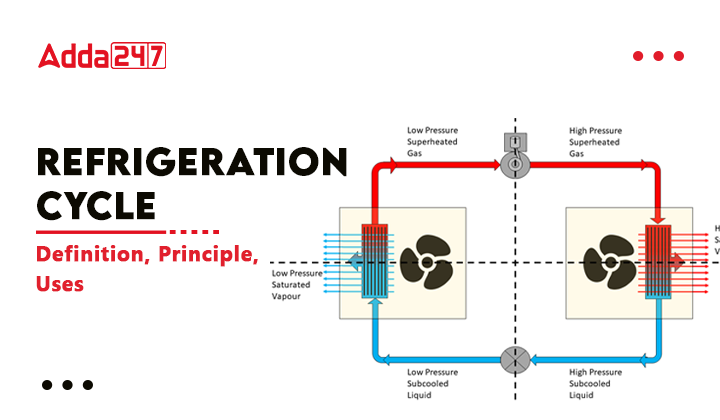Table of Contents
Refrigeration Cycle
The refrigeration cycle is a fundamental thermodynamic process used in refrigeration, air conditioning, and heat pump systems to transfer heat from one location to another. It allows for the cooling of spaces, preservation of food, and various other applications where temperature control is necessary. It’s a continuous cycle that involves the circulation of a refrigerant through four main components: the evaporator, compressor, condenser, and expansion valve.
Refrigeration Cycle Components
The Refrigeration Cycle typically consists of four main components: a compressor, a condenser, an expansion valve, and an evaporator. Here’s an overview of Refrigeration Cycle Components.
Compressor
The cycle begins in the compressor, which is typically located outside the refrigerated space. The compressor’s function is to raise the pressure and temperature of a low-pressure, low-temperature vapor refrigerant gas, such as Freon (R-134a) or ammonia (NH3). As the refrigerant is compressed, its molecules become packed closer together, increasing its energy and temperature.
Condenser
The high-pressure, high-temperature refrigerant gas from the compressor is then sent to the condenser, usually located outside the system. In the condenser, the refrigerant releases heat to the surrounding air or water, causing it to undergo a phase change from a gas to a high-pressure liquid. The heat transfer and phase change result in a significant decrease in temperature and pressure.
Expansion Valve
The high-pressure liquid refrigerant is now directed to an expansion valve or throttling device. The expansion valve reduces the pressure of the refrigerant abruptly, causing it to undergo a rapid expansion. This expansion process leads to a sudden drop in temperature, turning the high-pressure liquid into a low-pressure, low-temperature mixture of liquid and vapor.
Evaporator
The low-pressure refrigerant mixture enters the evaporator, which is located inside the area to be cooled. In the evaporator, heat is absorbed from the surrounding environment (such as the air or the contents of a refrigerator) by the refrigerant. This heat absorption causes the refrigerant to evaporate, turning it back into a low-pressure vapor.
The low-pressure vapor is then drawn back into the compressor, and the cycle repeats. By continuously cycling through these four stages, the refrigeration system effectively removes heat from the desired space and releases it outside, maintaining a lower temperature inside the refrigerated area.
This cycle allows for the cooling or freezing of products, air conditioning of buildings, and the operation of heat pumps that can provide both heating and cooling functions. The choice of refrigerant, as well as the efficiency and design of each component, plays a crucial role in the overall performance of the refrigeration system.
Principle of Refrigeration
The principle of refrigeration is based on the fundamental laws of thermodynamics, primarily the Second Law of Thermodynamics, which states that heat naturally flows from regions of higher temperature to regions of lower temperature. In the context of refrigeration, the main goal is to remove heat from a specific space or substance, effectively lowering its temperature.
The principle of refrigeration relies on the controlled circulation of refrigerant to transfer heat from a cooler area (the refrigerated space) to a warmer area (the external environment). By manipulating the properties of the refrigerant through compression, condensation, expansion, and evaporation, the system can maintain a lower temperature within the desired space, achieving cooling or refrigeration. Refrigeration systems are essential in various applications, including food preservation, air conditioning, industrial processes, and more.
Uses of Refrigeration Cycle
The refrigeration cycle is a fundamental thermodynamic process with numerous practical applications across various industries and everyday life. Here are some of the most common uses of the refrigeration cycle:
- Food Preservation and Storage
- Commercial and Industrial Refrigeration
- Air Conditioning
- HVAC systems
- Medical and Pharmaceutical Storage
- Transportation Refrigeration
- Chemical and Petrochemical Processes
- Medical Imaging and Laboratories
- Environmental Testing
These are just a few examples of the many uses of the refrigeration cycle. It is a crucial technology that significantly impacts our modern way of life, enabling us to preserve and control temperatures in various environments and processes.







 MPPKVVCL Recruitment 2025 Notification O...
MPPKVVCL Recruitment 2025 Notification O...
 WBSEDCL JE Recruitment 2025 Out, Apply O...
WBSEDCL JE Recruitment 2025 Out, Apply O...
 How Can I Crack RRB JE In First Attempt?
How Can I Crack RRB JE In First Attempt?





